
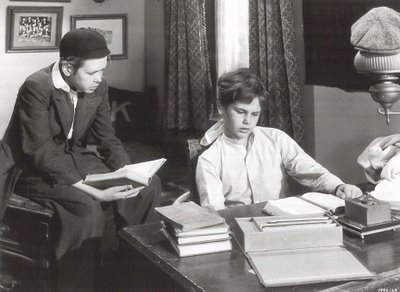
Those Happy Years Watching The Happy Years
Sometimes a good picture can be jinxed by a campaign that refuses to jell --- then there are those shows left at the starting post as sales personnel devote themselves to more promising releases. Everything fell apart for The Happy Years from the moment it was trade-shown on May 24, 1950. MGM had unveiled Annie Get Your Gun to exhibitors the day before, and excitement had been building for another big one, Father Of The Bride. These were the leviathans that would roll over The Happy Years, and fifty-seven years later, it’s still on the canvas. We can only guess as to what went wrong, but trade scribes hinted at the problem. Ads covered with type and cluttered posters, said The Manager’s Round Table section of The Motion Picture Herald --- very little illustration, so you have to read to get the point. One-sheets were uninspired, as shown here, and limited to headshots of an unpresupposing cast. What exactly was Metro selling? No one seemed to get a handle on how to exploit The Happy Years. It was based on "beloved" stories that had run in The Saturday Evening Post over the last eleven years, but was Post reader familiarity enough to get back $1.3 million spent on this Technicolor period piece? Costumers were hard enough to merchandise with stars on board (witness The Tall Target), so how do you excite patrons over a boy’s prep school setting at the turn of the century? In the end, I suspect they just gave up. The Happy Years headed double bills with another MGM forfeit, Mystery Street (loss --- $277,000). This is a grand picture and deserved better results, said one showman concluding his dispirited run of The Happy Years. Worthy shows had been dumped before and would be again, but it was particularly sad seeing this one swept under the carpet. As Annie Get Your Gun and Father Of The Bride racked up enormous grosses, The Happy Years withered in the heat of a summer playoff and finished with an egregious $680,000 in domestic rentals, plus an appalling $179,000 foreign (again, that curse of Americana). A million-dollar loss was recorded in Metro ledgers, and there would be no re-issues, other than a few bookings among the MGM Children’s Matinee series of the early seventies where it was re-titled The Adventures Of Young Dink Stover. Those who cared might have seen The Happy Years previously on television, as it had gone into syndication for Fall 1964 with 39 other post-48 Metros. The (very) few prints in circulation among collectors were either heisted from Films, Inc. or some TV station. I’ve not yet met anyone who didn’t like this picture. Occasionally there are sightings on TCM, but otherwise The Happy Years is orphaned. There’s never been a video release. I’ve watched interviews with Dean Stockwell in hopes it would be mentioned, but he’d rather talk about the glories of having done Blue Velvet.
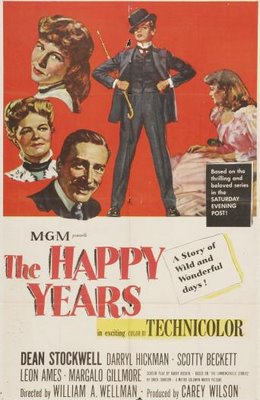
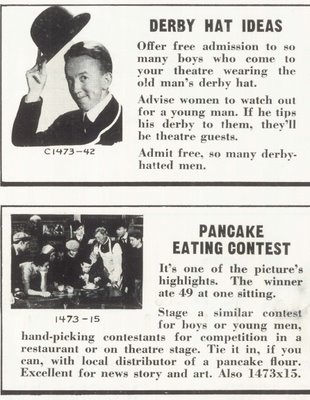
My father went to a boy’s school very much like Lawrenceville, the setting of The Happy Years. He particularly enjoyed the picture when we saw it on the old SFM Holiday Network presentation around 1981, but is there anyone left who would understand, even remotely, the student’s life he identified with? This was truly a movie for men who’d come of age near the turn of the (past) century. No one born since could comprehend, nor dramatize, that world so well. Producer Carey Wilson, born 1889, was enamoured of the project, having been a faithful reader of the Lawrenceville stories. Chances are he attended a place very much like it. Director William Wellman had been an outstanding athlete in high school, though it’s been suggested he never finished. He was born in 1896. These men brought an old-world sensibility to The Happy Years. Both were fascinated by the culture of a boy’s academy. I’ve not experienced a place such as Lawrenceville, but their details seem authentic. I’d like to think my father’s sojourn at the McCallie School in Chattanooga, Tennessee was similar. He boarded there in the late teens. The night we watched The Happy Years, he surprised me when he turned and said at the end, "Now that was really good," a reaction no picture had gotten from him in my memory. Maybe his own experience in that universe of The Happy Years gave him insights into its larger truths. It took men of a certain age to appreciate the crucial distinction between gerunds and gerundives.
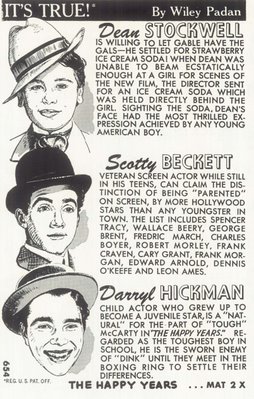
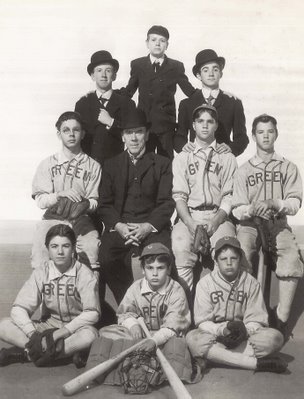

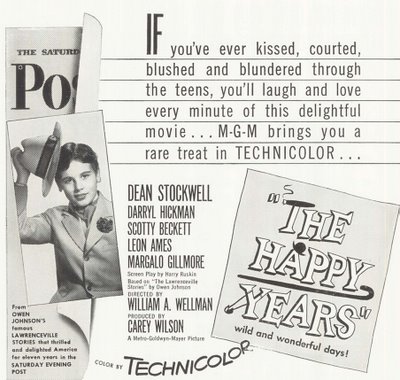
Youthful roles for Dean Stockwell, Darryl Hickman, and Scotty Beckett were nearly exhausted when they did The Happy Years. No longer boys in a cute sense, they were deep into adolescence and complications attendant thereto. Scotty had been arrested the year before for driving drunk. By the time The Happy Years went into production, he was twenty years old and married. The easy charm he projects in the movie was something he had plenty of in real life. It got him (barely) out of tough scrapes over a tumultuous adulthood until his luck ran out with a probable suicide (his third attempt) in 1968. Dean Stockwell was younger --- thirteen at the time The Happy Years was shot. This was his peak period, but late in the post-war day for child players to enter the game. He had the distinction of appearing in two classics released within weeks of each other --- Stars In My Crown and The Happy Years, but kid pictures of the kind MGM routinely turned out during the thirties and forties were disappearing fast, and Stockwell would only have a couple left before withdrawing several years to wait out puberty. Darryl Hickman was gangly and well past boy parts at eighteen, but he’d been in movies since If I Were King in 1938. He was on that Robert Osborne child star panel some months back and gave a good account of himself. I found it hard to believe someone so youthful in appearance and attitude could be seventy-five as of 2006. He has a book coming out in April, and it’s received advance praise. Also, there’s a website. Brother Dwayne’s in The Happy Years as well, though I’ve had no success spotting him. Neophyte Robert Wagner is recognizable, however.



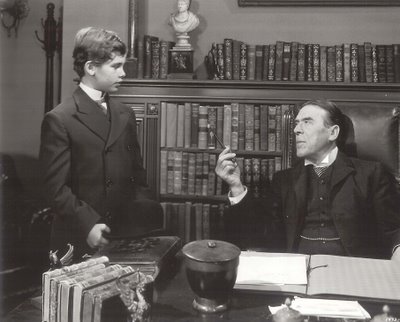
Variety suggested trims. The Happy Years was both leisurely and overlong. It’s admittedly relaxed as to pacing, but wasn’t life itself similarly laid back in those waning days of the gay nineties? I’d not vote to remove a moment of those 110 minutes, but much of that reflects my sentiment where this show is concerned. Was life so idyllic in that final decade of the nineteenth century? MGM certainly implied it was. Patriarch of choice Leon Ames is on hand as usual, and the comforting reassurance of that familiar Meet Me In St. Louis house (even against a beach set matte painting) made The Happy Years seem of a piece with the earlier musical hit. Red Skelton’s Excuse My Dust of the following year would utilize the same standing sets. Much of the furniture seen in The Happy Years would be used again here. The celebration of times long past would prevail at Fox with Cheaper By The Dozen, and Warner’s Booth Tarkington stories would accommodate Doris Day’s formula On Moonlight Bay and By The Light Of The Silvery Moon. These confections revolved around approximately the same period of American history. There must have been a fifties consensus that life in the nineties was simpler (if not preferable). Will we look back on any decade of the twentieth century with as much nostalgia? For a while, it seemed as though the sixties would reclaim us. American Graffiti ushered in a seventies longing for drive-ins and hopped-up cars, but that era seems now like ancient history (as do the seventies themselves). It’s hard to imagine anyone wanting to revisit our recently past eighties and nineties, but who knows? --- there must be someone with nostalgic recollections of those benighted decades. Why would movies ever embrace the nineteenth century again? Might as well revisit lives of the pharaohs , and that’s all the more reason to treasure The Happy Years, because we’re never going to get pictures the likes of this again. The people who could mount them are gone and they didn’t leave instructions behind.